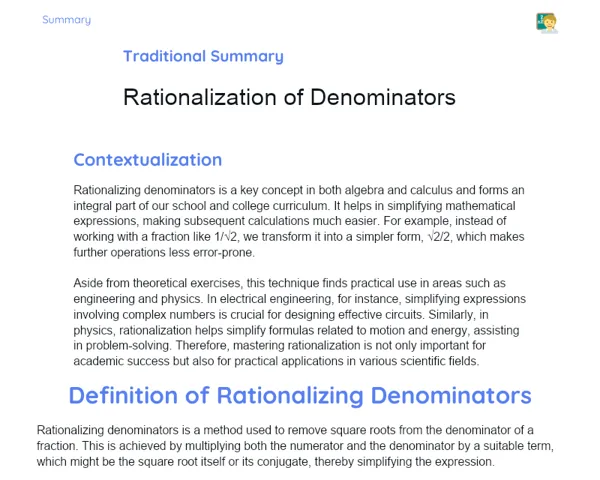Summary Tradisional | Angle Measurement
Contextualization
Angles appear in many everyday situations and play a vital role in subjects like mathematics, physics, and even physical education. Whether you are admiring the curves of a heritage building or planning the layout of a sports field, understanding angles helps us make sense of the world. For instance, architects and engineers in India use precise angle measurements to design safe structures, while in creative fields, such as animation and even in cricket field placements, angles guide effective design and strategy. In mathematics, a solid grasp of angles forms the basis for geometry and trigonometry, and accurate measurement skills come in handy in various practical trades like carpentry and crafting. Hence, learning about angles and how to measure them is a useful skill across many different domains.
To Remember!
Definition of Angle
An angle is created when two lines or rays meet at a common point, known as the vertex. The size of the angle is measured in degrees (°) and represents the gap or opening between these lines. Think of it like a pair of scissors in action; the point where the two blades meet is the vertex, and the space between them is the angle. This simple yet fundamental idea is crucial not only for mathematical studies but also for practical fields like engineering, architecture, and design. Establishing a clear definition of an angle helps us classify and solve various geometric problems, making it a building block for more advanced concepts.
-
An angle is formed by the intersection of two lines or rays from a common point (the vertex).
-
The measure of an angle is indicated in degrees (°), showing the opening between the lines.
-
A clear understanding of what an angle is forms the basis for exploring more advanced geometric concepts.
Types of Angles
Angles are generally categorized by their measurements into four main types: acute angle, right angle, obtuse angle, and straight angle. An acute angle, which measures less than 90°, might remind you of a slightly opened pair of scissors. A right angle, measuring exactly 90°, is what you see when two walls meet at a perfect corner, like many traditional Indian homes. An obtuse angle is one that lies between 90° and 180°, similar to the opening of a door that isn’t fully open, and a straight angle measures exactly 180°, forming a straight line. Understanding these different types of angles is essential for solving geometric problems and for applications in construction, art, and various engineering fields.
-
Acute angle: measures less than 90°.
-
Right angle: measures exactly 90°.
-
Obtuse angle: measures more than 90° and less than 180°.
-
Straight angle: measures exactly 180°.
Measuring Instrument: Protractor
The protractor is the key instrument used to measure angles. Typically, it has a straight or semicircular base with a degree scale ranging from 0° to 180° or even 360° depending on the type. It comes with a marked central point which should be aligned with the vertex of the angle being measured. Once the central point is set, the scale helps you read the angle accurately. Whether you are in a classroom or a workshop, mastering the use of a protractor is essential for precision in tasks ranging from design to technical drawing.
-
The protractor is a tool that helps measure angles using a scale marked in degrees.
-
Ensure the central point of the protractor is exactly at the vertex of the angle for an accurate reading.
-
Carefully reading the scale on the protractor ensures precise angle measurement.
How to Measure Angles with a Protractor
Measuring an angle with a protractor is straightforward if you follow a few simple steps. First, place the protractor so that its centre aligns exactly with the vertex of the angle. Next, have one side of the angle along the base line of the protractor. Then, read the value on the protractor's scale where the other side of the angle falls. It is important to hold the protractor steady to avoid errors commonly made by misalignment or reading the wrong scale. Practicing this on different geometric figures – starting from simple triangles to more complex shapes – will build confidence and accuracy, making it easier for students to apply these skills both in theory and in practical scenarios.
-
Place the central point of the protractor on the vertex of the angle.
-
Align one side of the angle with the base line of the protractor.
-
Read the angle measure directly from the scale matching the other side.
Key Terms
-
Angle: The opening created by the intersection of two lines or rays from a common point (vertex).
-
Protractor: A tool used to measure angles, marked with a scale of degrees.
-
Acute Angle: An angle that measures less than 90°.
-
Right Angle: An angle that measures exactly 90°.
-
Obtuse Angle: An angle that measures more than 90° and less than 180°.
-
Straight Angle: An angle that measures exactly 180°.
Important Conclusions
In this lesson, we revisited the fundamental definition of an angle – the opening formed by the intersection of two lines at a vertex. We looked at different types of angles, namely acute, right, obtuse, and straight angles, and saw how each is identified based on its degree of opening. We also explored the protractor, the primary tool used to measure angles, and discussed the correct way to use it. The ability to measure angles accurately is not only crucial for academic pursuits in mathematics and geometry but also finds practical applications in fields such as construction, engineering, and art. This foundational knowledge is important for both everyday problem-solving and advanced design work.
Study Tips
-
Practice measuring angles on both drawn diagrams and real-life objects using a protractor to gain better accuracy.
-
Review and work through exercises that require identifying and measuring different types of angles to strengthen your understanding.
-
Look into real-world applications, such as in architecture or engineering projects, to see how angle measurement is used practically.



